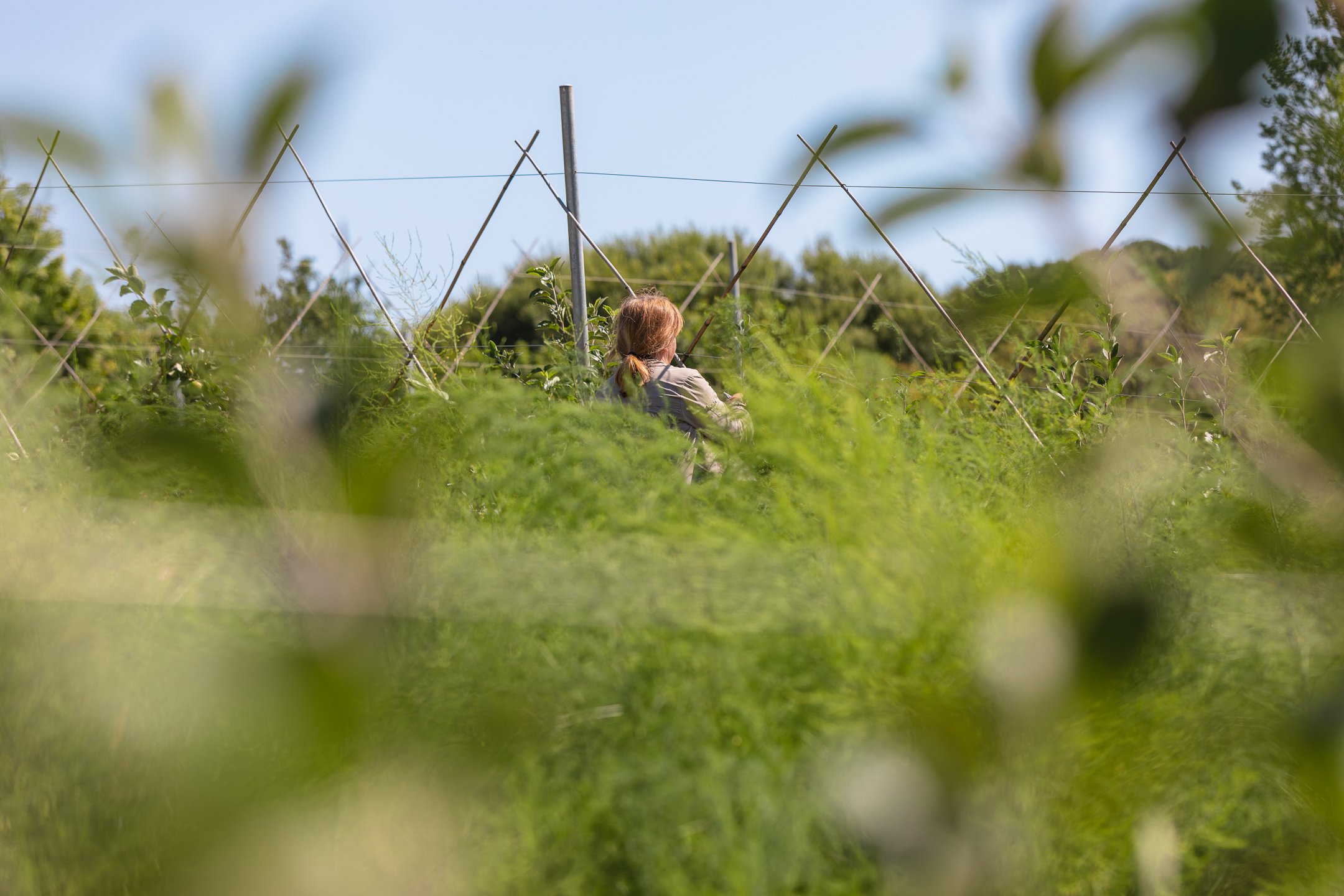
The story so far
Approximately thirty years ago, Lower Polscoe Farm diversified, after x many years as a dairy farm the owners hung up their boots and slipped into some golfing shoes, trading green fields for putting greens and cows for caddies. With that decision, the Lostwithiel Golf and Country Club was born, an institution that would provide its 300 members with a quality golf course up until its closure in 2014. In the years that followed, much of the site, including the clubhouse, hotel, and car park, was gradually developed into private accommodation until all that remained of the course was 16 of the original 18 holes.
Sadly, a history of poor course management had left the fairways in a sorry state of repair. Left untended, bio-diversity and nutrient contents across the land had fallen away, resulting in a tough thatch setting in under the grasses. The greens had died back almost entirely - the result of a mixture of drought, and an infestation of leatherjacket larvae, much favoured by badgers who had scrubbed up the green boundaries to get at them. At the waters edge it was much the same story, with no riverside maintenance or lake stewardship for years , the banks had descended into a motley collection of self-seeded willows, with debris from fallen ash and sycamore trees alongside other detritus blocking the river-ways between islands.
Soon after the country clubs closure we were approached by a former member of the golf club to see whether there was anything we could do to save the course. After going to view the site, we instantly fell in love with the sweep of the land and spurred on by decades of horticultural experience, we made the decision to buy the course and begin planning the extensive renovations it would take to return it to playable condition.
The course we bought was divided into two parts; one either side of Cott Road. To the east of Cott Road was former agricultural land which had been constructed into a golf course with the addition of greens, tees and man-made hazards, hillocks and carries. These had been formed by burying aggregates and other waste materials, all of which would have to be dug up and removed. To the west of Cott Road, looking down over the lake and the river with views up to Restormel Castle, Restormel Farm to the north-west and Lostwithiel to the south, remained 9 holes from the golf course, all of which needed complete restoration and three of which were on the river flood plain and unplayable for 3 months of the year.
Having bought the course in 2015 we solicited the views of previous members, many of whom committed to returning should the course reopen. It was understood that this could not be the whole course and the clear preference was to maintain the remains of the west course which was famously beautiful (holes 7, 8, 9, 11, 12, 13, 14, 15, and 18).
With there being no facilities nor car parking, we took the decision to begin serious maintenance on these holes to protect them for the future. We decided to build 9 new tees to enable the 9 holes to each be played from two approaches, both for reducing over heavy usage and to provide an 18 hole course for those interested.
The western golf course site went into extreme maintenance with a large team, including the greenkeeper from the original course, removing all the fallen and brash timber from the river and lakes, putting a team (which would take three years), working in partnership with Network Rail and the Duchy, removing the invasive Himalayan balsam, reopening the drainage channels across the course and restoring the footbridges which had been washed away in floods. Having opened up the old footpaths through the wild areas, we allocated large swathes of land to become “out of bounds” and “ecologically sensitive areas” to encourage the return of wildlife.
Similarly, the lake clearance was done in such a way as to open up access for waterfowl to reach nesting spaces on the island and southern edge of the lake, both areas designated free from fishing. Large numbers of duck and geese and some moorhen have since returned
We soon learned that the land of the eastern side of Cott Road was in a much worse state than anticipated, with the lack of nutrients in the soil there attested to by the extremely stunted growth of the many oak trees who have reached little more than 10ft in height after 30 years. Observing adjacent land, not owned by us and left to nature, it is clear to see that the lack of plant diversity has created simple clumping on top of thatch and sour grass. Working with Seth Pascoe (from Cornish SeaBerry Company), we have spent three years enriching the grassland, removing inappropriate tree plantings and reinstating several miles of hedgerows that had been grubbed up to make the original golf course (on holes 2, 3, 4, 5, and 6, and planting thousands of oak, beech, hazel, hawthorn, whitethorn, elderberry, guelder rose, bulaces, Keay plum, and more).
In addition to this, during the summer and autumn of 2018, massive earthworks were done, especially south of the battlefield site north of the course, to remove tons of aggregate and building waste that had been buried on the course, returning the soil to fine grade horticultural land. The environmental survey has been helpful in evidencing the wildlife that is currently on the site, and also provides a benchmark for its increase, going forward.
Before purchasing the golf course we had taken our very dear friend and renowned horticultural pioneer, Philip McMillan Browse to see it in the hope that he might help us learn what we could grow there. Philip, who for years oversaw one of the world’s finest gardens and horticultural centres as the Director of RHS Wisley; has a deep rooted passion for heritage varieties and the resistance to their decline at the hands of big agriculture.
When Philip saw the golf course he was enraptured, spending several hours walking around the site on his visit, despite having no interest whatsoever in golf.
He felt the land to the east of Cott road could be perfect for creating the best and largest collection of rare Cornish fruit trees in existence today. He asked for soil tests, wind tests, and temperature readings to establish the ideal cropping that could be achieved here, as well as the best locations. It transpired that the closer to the river you get, the more variable the temperature and low cropping your fruit would be. The question we posed to Phillip was, ‘if you were planting a legacy orchard that people in 30 years’ time would say was a great thing to do, what would you grow?’
Many of the great fruit and nut trees that he recommended take many years to reach fruition. As the tests came back it became obvious that massive enrichment programmes were necessary for the soil, and that the landscape would need to be returned to its former shape and camber to make any harvesting viable. The plan took hold to create the most fabulous orchard imaginable, and that it should accompany a Potager Garden of similar proportion to Heligan (a kitchen garden modelled on the Royal Palace of Versailles’ kitchen garden - Le Potager de Roi).
The Heligan Kitchen Garden is populated by varieties grown at Heligan and available during a narrow band of time in the 1870’s. The Potager imagined for Lostwithiel would focus on rare European Vegetables and fruit that were on the verge of dying out at source, and unavailable on the market. Philip was certain that many of these crops could enjoy a great revival as the modern plants were seen to be without nutritional value and, in some cases had become highly allergenic. Recent research by Cranfield University) has demonstrated that apples bred over the last 50 years have been bad for us, having increased sugars and highly reduced phenols – the ingredient which had once meant that an apple a day would keep the doctor away.
In 2016, Philip developed a planting plan for the orchard and the vegetable garden. He sourced the fruit and nut trees, but found there were few available so had to commission the grafting of many of the varieties. Allowing for grafting, hardening off and so on, the trees would not be available until autumn 2019, while others wouldn’t be available until autumn 2020. Phillip then began to look at a mixture of other rare fruiting trees, which had either not been attempted in this part of the world or had fallen out of favour as the rise in commercial apple growing to supply the supermarkets began to take hold, including almonds, cherries, loquats, quetsche, mirabelles, plums, greengage, sweet prunes, damsons and more. The months of research and Philip’s lifetime of knowledge eventually resulted in our first stab at our orchard planting plan, and at that point, the idea for Gillyflower Farm was born.
The work and cost of such a project has been significant. We spent most of the summer of 2018 reinstating what had been golf holes 3, 4 and 5 back into their original form as an agricultural field. We also needed to deer-proof the orchards and create additional hedge lines following the original field plans we had discovered, to shield the fruit from the worst of the wind. Our resident agronomist set about adding various green manures and composts to begin the process of bringing life back into the sterile soils. In 2019, as 2,972 fruit trees were planted in terrible weather, we fell in love with the name Gillyflower - probably the finest Cornish apple, and which make up 20% of our apples across 20 acres. We have supplemented the Gillyflower with a further 9 rare Cornish apple varieties.
This autumn, a further 1000 trees have been planted, as well as large numbers of nut trees and apple trees on the golf course. The intention is that each hole of the golf course will have a distinctive horticultural flavour (just like Augusta).

